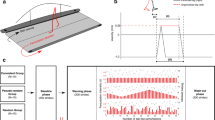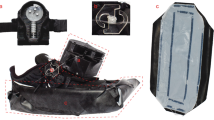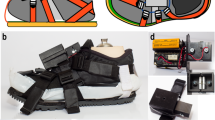Abstract
An unexpected slip during gait termination results in a generalised slip response designed to regain stability and prevent a fall. With knowledge of and experience with a slippery surface, locomotor behaviour adapts to proactively diminish the effect of the slip and improve the reactive control during the slip. Our purpose was to examine the organisation of the adaptation to a slippery surface during gait termination. After receiving an unexpected slip during gait termination, participants (N = 8) experienced cued gait termination trials in which they were given knowledge of the surface characteristics (i.e., slippery or non-slippery). The observed strategy used to repeatedly stop on a slippery surface involves proactively diminishing the size of the slip perturbation through a flattened foot at heel contact, anterior shift of the COM, shorter step, stance leg extension and swing limb slowing, as well as improving the reaction to the slippery surface through decreased muscle activity and an appropriate decrease in the braking force generation. The implications of this research are that a combination of knowledge of and experience with a slippery surface enables proactive and reactive adjustments in behaviour to effectively and more safely stop walking on a slippery surface.





Similar content being viewed by others
References
Bhatt T, Pai YC (2005) Long-term retention of gait stability improvements. J Neurophysiol 94(3):1971–1979
Bhatt T, Pai YC (2008a) Can observational training substitute motor training in preventing backward balance loss following an unexpected slip during walking? J Neurophysiol 99(2):843–852
Bhatt T, Pai YC (2008b) Immediate and latent interlimb transfer of gait stability adaptation following repeated exposure to slips. J Mot Behav 40(5):380–390
Bhatt T, Pai YC (2009) Prevention of slip-related backward balance loss: the effect of session intensity and frequency on long term retention. Arch Phys Med Rehabil 90:34–42
Bhatt T, Wening JD, Pai YC (2006a) Adaptive control of gait stability in reducing slip-related backward loss of balance. Ex Brain Res 170(1):61–73
Bhatt T, Wang E, Pai Y-C (2006b) Retention of adaptive control over varying intervals: prevention of slip-induced backward balance loss during gait. J Neurophysiol 95:2913–2922
Bishop M, Brunt D, Pathare N, Patel B (2004) The effect of velocity on the strategies used during gait termination. Gait Posture 20:134–139
Brady RA, Pavol MJ, Owings TM, Grabiner MD (2000) Foot displacement but not velocity predicts the outcome of a slip induced in young subjects while walking. J Biomech 33:803–808
Cao C, Ashton-Miller JA, Schultz AB, Alexander NB (1998) Effects of age, available response time and gender on ability to stop suddenly when walking. Gait Posture 8:103–109
Cham R, Redfern MS (2002) Changes in gait when anticipating slippery floors. Gait Posture 15:159–171
Crenna P, Cuong DM, Brénière Y (2001) Motor programmes for the termination of gait in humans: organization and velocity-dependent adaptations. J Physiol 537.3:1059–1072
Gao C, Abeysekera J (2004) A systems perspective of slip and fall accidents on icy and snowy surfaces. Ergonomics 47(5):573–598
Hase K, Stein RB (1999) Turning strategies during human walking. J Neurophysiol 81:2914–2922
Heiden TL, Sanderson DJ, Inglis JT, Siegmund GP (2006) Adaptations to normal human gait on potentially slippery surfaces: the effects of awareness and prior slip experience. Gait Posture 24:237–246
Henry SM, Fung J, Horak FB (1998) EMG responses to maintain stance during multidirectional surface translations. J Neurophysiol 80:1939–1950
Jaeger R, Vanitchatchavan P (1992) Ground reaction forces during termination of human gait. J Biomech 25:1233–1236
Järvinen TLN, Sievänen H, Khan KM, Heinonen A, Kannus P (2008) Shifting the focus in fracture prevention from osteoporosis to falls. BMJ 336:124–126
Jian Y, Winter DA, Ishac MG, Gilchrist L (1993) Trajectory of the body COG and COP during initiation and termination of gait. Gait Posture 1:9–22
Kannus P, Sievänen H, Palvanen M, Järvinen T, Parkkari J (2005) Prevention of falls and consequent injuries in elderly people. Lancet 366:1885–1893
Karinkanta S, Heinonen A, Sievänen H, Uusi-Rasi K, Kannus P (2005) Factors predicting dynamic balance and quality of life in home-dwelling elderly women. Gerontology 51:116–121
Liu-Ambrose T, Donaldson MG, Ahamed Y, Graf P, Cook WL, Close J, Lord SR, Khan KM (2008) Otago home-based strength and balance retraining improves executive functioning in older fallers: A randomized controlled trial. J Am Geriatric Soc 56:1821–1830
Marigold DS, Patla AE (2002) Strategies for dynamic stability during locomotion on a slippery surface: effects of prior experience with and knowledge about surface characteristics. J Neurophysiol 88:339–353
Marigold DS, Bethune AJ, Patla AE (2003) Role of the unperturbed limb and arms in the reactive recovery response to an unexpected slip during locomotion. J Neurophysiol 89:1727–1737
Meier MR, Desrosiers J, Bourassa P, Blaszczyk J (2001) Effect of type II diabetic peripheral neuropathy on gait termination in the elderly. Diabetologia 44:575–592
Menant JC, Steele JR, Menz HB, Munro BJ, and Lord SR. (2008). Effects of walking surfaces and footwear on temporo-spatial gait parameters in young and older people. Gait Posture. doi:10.1016/j.gaitpost.2008.10.057
Myung R, Smith JL (1997) The effect of load carrying and floor contaminants on slip and fall parameters. Ergonomics 40(2):235–246
Nieuwenhuijzen PHJA, Schillings AM, Van Galen GP, Duysens J (2000) Modulation of the startle response during human gait. J Neurophysiol 84:65–74
O’Kane FW, McGibbon CA, Krebs DE (2003) Kinetic analysis of planned gait termination in healthy subjects and patients with balance disorders. Gait Posture 17:170–179
Oates AR, Patla AE, Frank JS, Greig MA (2005) Control of dynamic stability during gait termination on a slippery surface. J Neurophysiol 93:64–70
Pai YC, Wening JD, Runtz EF, Iqbal K, Pavol MJ (2003) Role of feedforward control of movement stability in reducing slip-related balance loss and falls among older adults. J Neurophysiol 90:755–762
Perry SD, Santos LC, Patla AE (2001) Contribution of vision and cutaneous sensation to the control of centre of mass (COM) during gait termination. Brain Res 913:27–34
Tang P, Woollacott MH, Chong RKY (1998) Control of reactive balance adjustments in perturbed human walking: roles of proximal and distal postural muscle activity. Exp Brain Res 199:141–152
Tinetti ME (2003) Preventing falls in elderly persons. New Engl J Med 348(1):42–49
Troy KL, Grabiner M (2006) Recovery responses to surrogate slipping tasks differ from responses to actual slips. Gait Posture 24(4):441–447
Vreiling AH, van Keeken HG, Schoppen T, Otten E, Halbertsma JPK, Hof AL, Postema K (2008) Gait termination in lower limb amputees. Gait Posture 27:82–90
Winter DA, Patla AE (1997) Signal processing and linear systems for the movement sciences. Waterloo Biomechanics, Waterloo
Acknowledgments
The authors would like to gratefully acknowledge the support of Natural Sciences and Engineering Research Council of Canada and the Canadian Institutes of Health Research Multidisciplinary Team on Locomotor Rehabilitation during the development of this manuscript.
Author information
Authors and Affiliations
Corresponding author
Rights and permissions
About this article
Cite this article
Oates, A.R., Frank, J.S. & Patla, A.E. Control of dynamic stability during adaptation to gait termination on a slippery surface. Exp Brain Res 201, 47–57 (2010). https://doi.org/10.1007/s00221-009-2011-2
Received:
Accepted:
Published:
Issue Date:
DOI: https://doi.org/10.1007/s00221-009-2011-2




